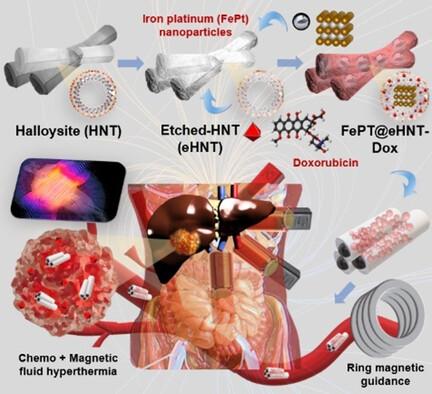Magnetically Guided Theranostics: Novel Nanotubular Magnetic Resonance Imaging Contrast System Using Halloysite Nanotubes Embedded with Iron–Platinum Nanoparticles for Hepatocellular Carcinoma Treatment
引用次数: 0
Abstract
Halloysite nanotubes (HNTs) have a layered structure of clay silicate minerals and a tubular shape, which is suitable for the uniform loading of small substrates and drug molecules. The inner diameter of HNTs with an acidic solvent is selectively etched to increase the loading capacity of magnetic iron–platinum (FePt) nanoparticles. The FePt nanoparticles and etched HNTs (eHNT) are then composited by vacuum decompression. The resulting product is named FePt@eHNT and is used as a contrast agent for T2-weighted magnetic resonance imaging. According to a comprehensive analysis of the material and its magnetic properties, by adding different proportions of HNTs before and after modification, the saturation magnetization can reach 23.769 emu g−1, which is higher than that of the composite materials studied in previous studies. This is because the tubular structure promotes the orderly displacement of the FePt nanoparticles under three-dimensional space constraints and the uniform effect of the magnetic field. In addition, the magnetothermal effect of the composite material is observed and its potential as an imaging agent is investigated. In this study, the enhancement of its ferromagnetism and its potential to become a multifunctional composite material for applications in drug delivery, magnetic hyperthermia, and bioimaging is demonstrated.

磁导治疗学:利用嵌入铁-铂纳米粒子的海泡石纳米管治疗肝细胞癌的新型纳米管磁共振成像对比系统
霍洛石纳米管(HNTs)具有粘土硅酸盐矿物的层状结构和管状形状,适合均匀装载小基质和药物分子。利用酸性溶剂对 HNTs 的内径进行选择性蚀刻,可提高磁性纳米铁铂(FePt)粒子的负载能力。然后通过真空减压将 FePt 纳米粒子和蚀刻 HNT(eHNT)复合在一起。得到的产品被命名为 FePt@eHNT,可用作 T2 加权磁共振成像的造影剂。根据对该材料及其磁性能的综合分析,通过在改性前后添加不同比例的 HNT,其饱和磁化率可达 23.769 emu g-1,高于以往研究的复合材料。这是因为管状结构促进了 FePt 纳米粒子在三维空间限制和磁场均匀作用下的有序位移。此外,还观察了复合材料的磁热效应,并研究了其作为成像剂的潜力。这项研究证明了复合材料铁磁性的增强及其成为多功能复合材料的潜力,可应用于药物输送、磁热和生物成像等领域。
本文章由计算机程序翻译,如有差异,请以英文原文为准。
求助全文
约1分钟内获得全文
求助全文

 求助内容:
求助内容: 应助结果提醒方式:
应助结果提醒方式:


